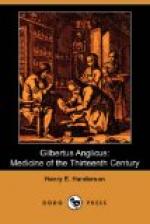This odd demonstration is followed by a succession of optical questions, which are discussed and answered in true scholastic style, with no little acuteness of observation. Thus: “Utrum visus fiat intus suscipiendo?” Is vision accomplished by something received into the eye? “Utrum color fit de nocte?” Does color exist at night? To the latter question Gilbert replies that in the darkness color exists in posse, but not in esse. Again: “Why do some animals see at night, some in the day only and some only in the twilight?” This phenomenon he ascribes to “the clearness and subtilty of the visual spirits, or to the strength, weakness, grossness or turbidity of the organs of vision.” Some animals, he says, have (visual) spirits, subtle and clear as fire, and these animals see perfectly at night because the visual spirits (spiritus visibilis) are sufficient to illuminate the external air. “Why do objects in water seem nearer than those in air?” Gilbert explains this as follows: “Nothing appears distant, except as perceived through an extensive intervening medium. But our judgment is largely guided by the transparency of this medium, since the medium itself is not perceived with much accuracy, except when it is transparent. Accordingly, as the lucidity of air is greater than that of water, an object looks more distant through air than through water.”
“Why does not a single object appear double, inasmuch as we have two eyes?” To this he replies: “From the anterior part of the brain two optic nerves pass to the two eyes. But these two nerves unite at a certain point into one. Now, since the two nerves are of equal length, two images proceeding from a single object do not make the object seem double, but single, since the two images are united into one, and accordingly one object is seen as one image.”
Other physiological speculations are introduced by the questions: “May one see an object not actually present?” “Why do some animals see best objects at a distance, others those near at hand?” “Why are objects seen in their proper position?” All these questions are answered in accordance with the scholastic formulae, and, not infrequently, with considerable acuteness.
A chapter entitled “De signis oculorum” also introduces us to a curious discussion of ocular physiognomy. Thus:
“When we see a man with large eyes, we argue that he is indolent.”
“If his eyes are deeply situated in his head, we say that he is crafty and a deceiver.”
“If his eyes are prominent, we say that he is immodest, loquacious and stupid.”
“He whose eyes are mobile and sharp is a deceiver, crafty and a thief.”
“He whose eyes are large and tremulous is lazy and a braggart (spaciosus?), and fond of women.”
and so forth for an entire page of the Compendium.




